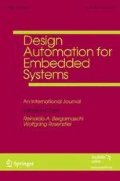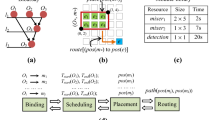Abstract
Microfluidic biochips are replacing the conventional biochemical analyzers, and are able to integrate on-chip all the necessary functions for biochemical analysis. The “digital” biochips are manipulating liquids as discrete droplets on a two-dimensional array of electrodes. Basic microfluidic operations, such as mixing and dilution, are performed on the array, by routing the corresponding droplets on a series of electrodes. So far, researchers have assumed that these operations are executed on virtual rectangular devices, formed by grouping several adjacent electrodes. One drawback is that all electrodes are considered occupied during the operation execution, although the droplet uses only one electrode at a time. Moreover, the operations can actually be performed by routing the droplets on any sequence of electrodes on the microfluidic array. Hence, in this paper, we eliminate the concept of virtual devices and allow the droplets to move on the chip on any route during operation execution. Thus, the synthesis problem is transformed into a routing problem. We develop an algorithm based on a Greedy Randomized Adaptive Search Procedure (GRASP) and we show that routing-based synthesis leads to significant improvements in the application completion time compared to traditional synthesis based on virtual devices. However, the disadvantage of the routing-based approach is that it may contaminate larger areas of the biochip, when synthesizing applications containing liquids which may adsorb on the surface of the microfluidic array. We have extended the GRASP-based algorithm to consider contamination avoidance during routing-based synthesis. Several real-life examples and synthetic benchmarks are used to evaluate the proposed approaches.











Similar content being viewed by others
Notes
In this paper we consider the data from [20], where the time required to route the droplet one cell is 0.01 s.
Values for the parameters: no part =3, max electrodes =50.
References
Bazargan K, Kastner R, Sarrafzadeh M (2000) Fast template placement for reconfigurable computing systems. IEEE Des Test Comput 17(1):68–83. doi:10.1109/54.825678
Böhringer KF (2004) Towards optimal strategies for moving droplets in digital microfluidic systems. In: Proceedings of IEEE international conference on robotics and automation, pp 1468–1474
Campas M, Katakis I (2004) DNA biochip arraying, detection and amplification strategies. TrAC, Trends Anal Chem 23(1):49–62
Chakrabarty K, Zeng J (2005) Design automation for microfluidics-based biochips. ACM J Emerg Technol Comput Syst 1(3):186–223
Chakrabarty K, Fair RB, Zeng J (2010) Design tools for digital microfluidic biochips: towards functional diversification and more than Moore. IEEE Trans Comput-Aided Des Integr Circuits Syst 29(7):1001–1017. doi:10.1109/TCAD.2010.2049153
Cho M, Pan DZ (2008) A high-performance droplet router for digital microfluidic biochips. In: Proceedings of the international symposium on physical design, pp 200–206
Fair RB (2007) Digital microfluidics: is a true lab-on-a-chip possible? Microfluid Nanofluid 3(3):245–281
Feo TA, Resende MGC (1995) Greedy randomized adaptive search procedure. J Glob Optim 6:109–133
Griffith EJ, Akella S, Goldberg MK (2006) Performance characterization of a reconfigurable planar array digital microfluidic system. IEEE Trans Comput-Aided Des Integr Circuits Syst 25:340–352
Huang TW, Lin CH, Ho TY (2009) A contamination aware droplet routing algorithm for digital microfluidic biochips. In: Proceedings of the international conference on computer-aided design, pp 151–156
Maftei E (2011) Synthesis of digital microfluidic biochips with reconfigurable operation execution. Ph.D. thesis, Technical University of Denmark
Maftei E, Paul P, Madsen J, Stidsen T (2008) Placement-aware architectural synthesis of digital microfluidic biochips using ILP. In: Proceedings of the international conference on very large scale integration of system on chip, pp 425–430
Maftei E, Paul P, Madsen J (2009) Tabu search-based synthesis of dynamically reconfigurable digital microfluidic biochips. In: Proceedings of the compilers, architecture, and synthesis for embedded systems conference, pp 195–203
Maftei E, Paul P, Madsen J (2010) Routing-based synthesis of digital microfluidic biochips. In: Proceedings of the compilers, architecture, and synthesis for embedded systems conference, pp 41–49
Maftei E, Paul P, Madsen J (2010) Tabu search-based synthesis of digital microfluidic biochips with dynamically reconfigurable non-rectangular devices. Des Autom Embed Syst 14:287–308
Melin J, Quake SR (2007) Microfluidic large-scale integration: the evolution of design rules for biological automation. Annu Rev Biophys Biomol Struct 36:213–231
Miller E, Wheeler AR (2009) Digital bioanalysis. Anal Bioanal Chem 393(2):419–426
Moon H, Wheeler AR, Garrell RL, Loo JA, Kim CJ (2006) An integrated digital microfluidic chip for multiplexed proteomic sample preparation and analysis by MALDI-MS. Lab Chip 6(9):1213–1219
Paik P, Pamula VK, Fair RB (2003) Rapid droplet mixers for digital microfluidic systems. Lab Chip 3:253–259
Pollack MG, Shenderov AD, Fair RB (2002) Electrowetting-based actuation of droplets for integrated microfluidics. Lab Chip 2:96–101
Ren H, Fair RB (2002) Micro/nano liter droplet formation and dispensing by capacitance metering and electrowetting actuation. In: Proceedings of the IEEE-NANO, pp 369–372
Ren H, Srinivasan V, Fair RB (2003) Design and testing of an interpolating mixing architecture for electrowetting-based droplet-on-chip chemical dilution. In: Proceedings of the international conference on transducers, solid-state sensors, actuators and microsystems, pp 619–622
Sermon K, Goossens V, Seneca S, Lissens W, Vos AD, Vandervorst M, Steirteghem AV, Liebaers I (1998) Preimplantation diagnosis for Huntington’s disease (HD): clinical application and analysis of the HD expansion in affected embryos. Prenat Diagn 18(13):1427–1436
Srinivasan V, Pamula VK, Fair RB (2004) Droplet-based microfluidic lab-on-a-chip for glucose detection. Anal Chim Acta 507:145–150
Su F, Chakrabarty K (2005) Unified high-level synthesis and module placement for defect-tolerant microfluidic biochips. In: Proceedings of the design automation conference, pp 825–830 doi:10.1145/1065579.1065797
Su F, Hwang W, Chakrabarty K (2006) Droplet routing in the synthesis of digital microfluidic biochips. In: Proceedings of the design, automation and test in Europe, vol 1, pp 73–78
Thorsen T, Maerkl S, Quake S (2002) Microfluidic largescale integration. Science 298:580–584
Xu T, Chakrabarty K (2008) Integrated droplet routing and defect tolerance in the synthesis of digital microfluidic biochips. ACM J Emerg Technol Comput Syst 4(3). doi:10.1145/1389089.1389091
Yuh PH, Yang CL, Chang YW (2007) Placement of defect-tolerant digital microfluidic biochips using the T-tree formulation. ACM J Emerg Technol Comput Syst 3(3). doi:10.1145/1295231.1295234
Yuh PH, Yang CL, Chang YW (2008) BioRoute: A network-flow-based routing algorithm for the synthesis of digital microfluidic biochips. Trans Comput-Aided Des Integrated Circuits Syst 1928–1941
Zhao Y, Chakrabarty K (2009) Cross-contamination avoidance for droplet routing in digital microfluidic biochips. In: Proceedings of the conference on design, automation and test in Europe, pp 1290–1295
Zhao Y, Chakrabarty K (2010) Synchronization of washing operations with droplet routing for cross-contamination avoidance in digital microfluidic biochips. In: Proceedings of the design automation conference, pp 641–646
Author information
Authors and Affiliations
Corresponding author
Additional information
This work is based on an earlier work: Routing-Based Synthesis of Digital Microfluidic Biochips, in Proceedings of the International Conference on Compilers, Architecture and Synthesis for Embedded Systems [14] © ACM, 2010. http://doi.acm.org/10.1145/1878921.1878928.
Rights and permissions
About this article
Cite this article
Maftei, E., Pop, P. & Madsen, J. Routing-based synthesis of digital microfluidic biochips. Des Autom Embed Syst 16, 19–44 (2012). https://doi.org/10.1007/s10617-012-9083-0
Received:
Accepted:
Published:
Issue Date:
DOI: https://doi.org/10.1007/s10617-012-9083-0




